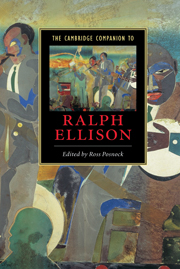Book contents
- Frontmatter
- Introduction
- 1 Ralph Ellison’s invented life
- 2 Ellison and the black Church
- 3 Ellison, photography, and the origins of invisibility
- 4 Ralph Ellison’s music lessons
- 5 Ralph Ellison’s constitutional faith
- 6 Ralph Ellison and the politics of melancholia
- 7 Invisible Ellison
- 8 Ellison’s experimental attitude and the technologies of illumination
- 9 Female iconography in Invisible Man
- 10 Chaos not quite controlled
- 11 Ralph Ellison, Hannah Arendt, and the meaning of politics
- 12 Dry bones
- Selected bibliography and suggestions for further reading
- Index
- Series List
3 - Ellison, photography, and the origins of invisibility
Published online by Cambridge University Press: 28 May 2006
- Frontmatter
- Introduction
- 1 Ralph Ellison’s invented life
- 2 Ellison and the black Church
- 3 Ellison, photography, and the origins of invisibility
- 4 Ralph Ellison’s music lessons
- 5 Ralph Ellison’s constitutional faith
- 6 Ralph Ellison and the politics of melancholia
- 7 Invisible Ellison
- 8 Ellison’s experimental attitude and the technologies of illumination
- 9 Female iconography in Invisible Man
- 10 Chaos not quite controlled
- 11 Ralph Ellison, Hannah Arendt, and the meaning of politics
- 12 Dry bones
- Selected bibliography and suggestions for further reading
- Index
- Series List
Summary
Among readers of Ellison, it is a truth universally acknowledged that the benchmark for his aesthetics and novelistic style is jazz. His own body of critical writing, as well as received readings of black modernism, insist on a definitive continuity between literature and music, from which visual culture remains at a considerable, historically determined distance. In often-cited essays on such blues and jazz legends as Duke Ellington, Louis Armstrong, Charlie Parker, and Charlie Christian; in remembrances of earlier jazz cultures; in the narrative rhythms of Invisible Man (which has been aptly described as ''a progression of jazz breaks taking off from and returning to the bass line of invisibility''): everywhere throughout his work, Ellison asks to be read as an ''ambidextrous'' figure, riffing on jazz and literary histories, thus responding to this American life and forging an authorial identity. Indeed, critic Robert O'Meally has identified jazz in America as ''Ellison's metaphor for democracy and love'' and ''the answer to the complicated question of identity'' in one. Ellison’s work is thus taken to exemplify the apercu that, throughout their history and in response to the social conditions of their emergence, all black arts aspire to the condition of music – most particularly, the high-flying, mind-bending, magisterial flights, the hot dizzy highs and soulful lows, of improvisatory jazz.
- Type
- Chapter
- Information
- The Cambridge Companion to Ralph Ellison , pp. 56 - 81Publisher: Cambridge University PressPrint publication year: 2005
- 1
- Cited by



